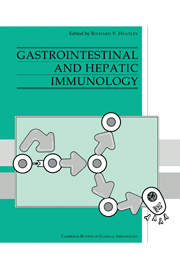Book contents
- Frontmatter
- Contents
- List of contributors
- Preface
- 1 Lymphoid cells and tissues of the gastrointestinal tract
- 2 Lymphocyte migration to the gut mucosa
- 3 Regulating factors affecting gut mucosal defence
- 4 Gastritis
- 5 The immunology of coeliac disease
- 6 Inflammatory bowel disease
- 7 Food intolerance and allergy
- 8 Gastrointestinal and liver involvement in primary immunodeficiency
- 9 Secondary immunodeficiency – the acquired immunodeficiency syndrome (AIDS)
- 10 Intestinal infections
- 11 Lymphomas
- 12 Small bowel transplantation
- 13 Clinical aspects of immunologically mediated intestinal diseases
- 14 Chronic active hepatitis
- 15 Primary biliary cirrhosis
- 16 Immunology and immunopathology of acute viral hepatitis
- 17 Immunology of liver transplantation
- 18 Clinical correlates with hepatic diseases
- Index
18 - Clinical correlates with hepatic diseases
Published online by Cambridge University Press: 03 February 2010
- Frontmatter
- Contents
- List of contributors
- Preface
- 1 Lymphoid cells and tissues of the gastrointestinal tract
- 2 Lymphocyte migration to the gut mucosa
- 3 Regulating factors affecting gut mucosal defence
- 4 Gastritis
- 5 The immunology of coeliac disease
- 6 Inflammatory bowel disease
- 7 Food intolerance and allergy
- 8 Gastrointestinal and liver involvement in primary immunodeficiency
- 9 Secondary immunodeficiency – the acquired immunodeficiency syndrome (AIDS)
- 10 Intestinal infections
- 11 Lymphomas
- 12 Small bowel transplantation
- 13 Clinical aspects of immunologically mediated intestinal diseases
- 14 Chronic active hepatitis
- 15 Primary biliary cirrhosis
- 16 Immunology and immunopathology of acute viral hepatitis
- 17 Immunology of liver transplantation
- 18 Clinical correlates with hepatic diseases
- Index
Summary
Introduction
Involvement of immune mechanisms in the pathogenesis of liver diseases is complex and poorly understood. It is often difficult to determine whether abnormalities in the immune system in patients with liver disease are due to a primary pathogenetic mechanism, arise as a consequence of the liver disease, or else whether immunological mechanisms modify the disease process. The advent of molecular biological techniques has allowed for major advances in the understanding of the role of the immune system in the pathogenesis of a variety of liver diseases but mechanisms still remain poorly understood. The earlier approaches which were limited to assessing phenotypic markers of peripheral lymphocyte subsets, have been overtaken by more sophisticated approaches where phenotypic, morphological and functional assessment of lymphocyte target/cell interactions have allowed elucidation of possible pathways of disease. None the less, extrapolation of in vitro observations to in vivo mechanisms is fraught with problems; availability of appropriate material for study is often limited by obvious clinical and ethical considerations. The in vitro reactions of cells from peripheral blood do not necessarily reflect the situation within the liver itself.
Of the various liver diseases in which immune mechanisms have been implicated, acute, cellular allograft rejection is probably the most clear-cut model, and therefore will be discussed in greater detail. In contrast, in primary biliary cirrhosis, patients have many immunological abnormalities and the disease is thought to belong in the ‘auto-immune’ group of disorders, yet immunosuppressive therapy is largely ineffective.
- Type
- Chapter
- Information
- Gastrointestinal and Hepatic Immunology , pp. 366 - 381Publisher: Cambridge University PressPrint publication year: 1994



